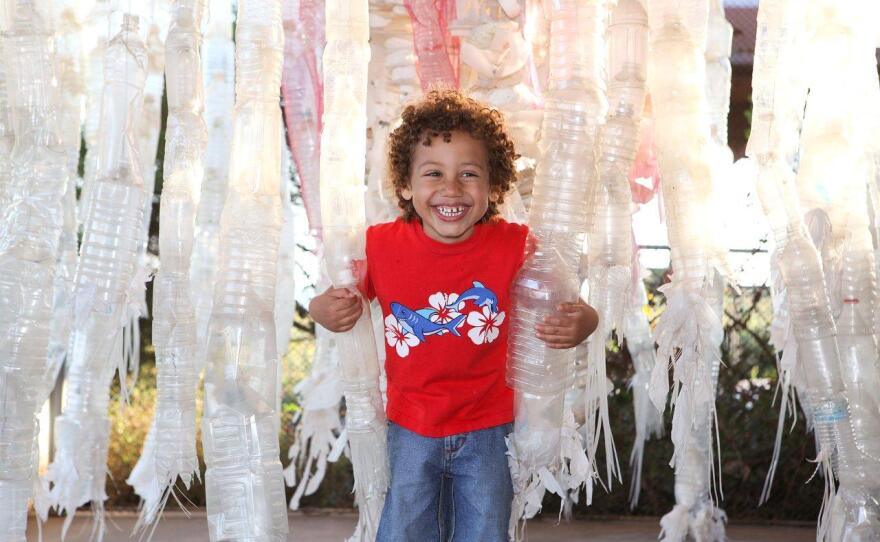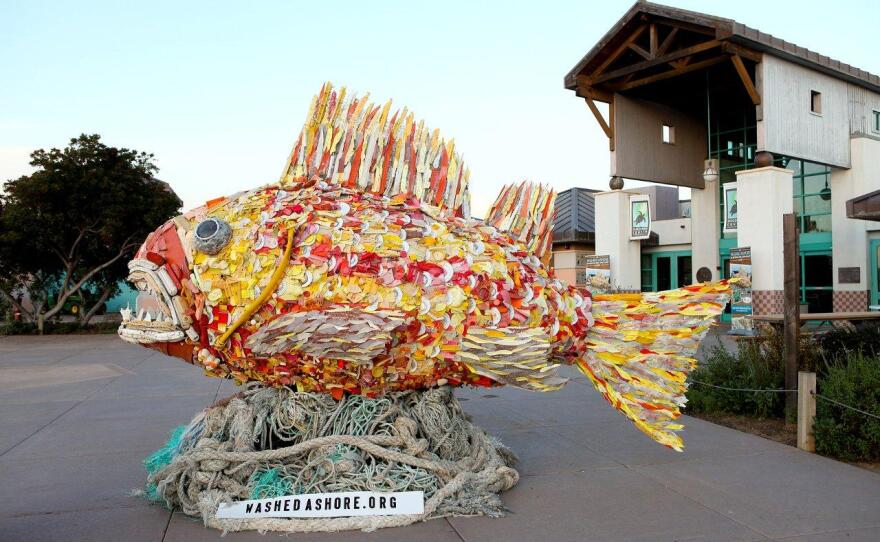ANCHOR INTRO: The Chula Vista Nature Center re-launched last month as the Living Coast Discovery Center. Its first exhibit under its new moniker is Washed Ashore: Plastics, Sea Life and Art. KPBS arts reporter Beth Accomando takes a tour of the exhibit with its creator. WASHED (ba).wav 3:57 Tag: Washed Ashore runs through September 3rd at the Living Coast Discovery Center in Chula Vista. Watch for Beth's video feature tonight at 6:30pm on KPBS Evening Edition. ============= TZWASHED.wav Can picking up a single piece of trash from the beach make a difference? ANGELA HASELTINE POZZI: Everything you do can make a difference and every little, tiny action builds something bigger, and that's probably the biggest most important message that this exhibit carries. Artist Angela Haseltine Pozzi [hazel-teen poat-zee] makes art out of plastic that washes up on beaches. KPBS arts reporter Beth Accomando explores the exhibit Washed Ashore to see how it raises awareness about ocean pollution. Okay, listen up. What does this sound like to you? CLIP Sound from Washed Ashore sculpture Does it sound like the ocean asking for help? Well, in a way that's exactly what it is. It's the sound of hundreds of discarded plastic water bottles strung together to make a giant jellyfish sculpture. ANGELA HASELTINE POZZI: These were just water bottles that all washed ashore there's a huge amount that come ashore. There are water bottles that we've been getting from the Beijing Olympics Artist Angela Haseltine Pozzi has been gathering garbage from the beaches in her coastal Oregon home for years as part of the Washed Ashore Project. ANGELA HASELTINE POZZI: We process it by hosing it down and sorting it and scrubbing it and soaking it and cutting it, drilling it. Then Haseltine Pozzi turns the trash into beautiful sculptures like the jellyfish that visitors can walk through or make spin around. ANGELA HASELTINE POZZI: What it does is it pulls you in and then they want to know what it's made of, they want to know how it's done, and they look at what it's made of and then we've got them, then we can educate people about this is garbage on the beaches. The sculptures pull people in with their visual appeal which is why executive director Dr. Brian Joseph wanted to bring the exhibit to the center. BRIAN JOSEPH: When you first look at these you think these are very beautiful sculptures and then when you approach them closer and closer, you are filled with horror because they are everyday items that we discard in the environment and we don't think twice about it, and it never breaks down, it'll be here 500 years from now. The Center's purpose is to connect people to nature and the environment with the hope of encouraging positive change. Washed Ashore directly addresses that message by drawing attention to the problem in a novel way. ANGELA HASELTINE POZZI: Would you want your picture taken in front of a big pile of trash? Probably not. People don't realize how bad it is by just listening to statistics and seeing charts. And I thought I need to do something that makes people really not ignore the problem. So make giant animal and they won't ignore it. Especially if it's an adorable sea turtle named Tula whose big round head is a garbage bin lid that washed ashore. Nine-year-old Meghan Palitz adores Tula and understands the message that the green plastic sculpture is trying to convey. MEGHAN PALITZ: It's supposed to teach kids how much like full of trash the ocean is and how we should take care of it. And I think it really works. Haseltine Pozzi was an educator for 3 decades before she started researching the impact of plastics on ocean habitats. She was confident her clever recycling of trash would appeal to kids. But she also wanted to reach people who littler on the beach or who have never used a recycled product. ANGELA HASELTINE POZZI: The plastic pollution problem in the ocean is huge and it is affecting every beach in the entire world. It's basically because humans have created this thing called plastic which lasts forever and right not in this day and age, we are producing 200 billion [pounds] a year of plastic. About 4% is getting recycled. The Washed Ashore Exhibit uses 3 tons of debris collected from beaches and is proof that every action has a tangible result. ANGELA HASELTINE POZZI: I tell people every piece of plastic here in this whole exhibit was once purchased by somebody and then it got tossed aside. One person at a time decided to pick up one piece of plastic and each one of those actions cleaned up a beach. By turning ugly trash into inspiring art, Haseltine Pozzi hopes people will start rethinking how they use plastic products. In addition to Tula the turtle, visitors to the center can find a Styrofoam coral reef, a harbor seal made up of so many lids that she's aptly named Lydia, and a fish made of plastic pieces with tooth marks from sea creatures that tried to eat the plastic and most likely died as a result. ANGELA HASELTINE POZZI: Art is a language that everyone can understand if it is used right. The Living Coast Discovery Center plans to use the exhibit to prompt a larger environmental education effort because as Haseltine Pozzi says, "Every piece of plastic tells a story – and it never goes away." Beth Accomando. KPBS News.
The Chula Vista Nature Center re-launched last month as the Living Coast Discovery Center (located at 1000 Gunpowder Point Drive in Chula Vista). Its first exhibit under its new moniker is Washed Ashore: Plastics, Sea Life and Art. The exhibit runs through September 3.
Take a tour of the exhibit with its creator. Listen to the radio feature or watch the video.
According to Discovery News, there's about 315 billion pounds of plastic in the oceans right now. That's a huge number. To try and put that in perspective, try to imagine what 3 tons of garbage looks like? It could look like this...

Or if you're artist Angela Haseltine Pozzi you can turn 3 tons of debris into this...

... Giant marine sculptures like a jellyfish made up of hundreds of discarded plastic water bottles strung together.
"These were just water bottles that all washed ashore there's a huge amount that come ashore. There are water bottles that we've been getting from the Beijing Olympics," says artist Haseltine Pozzi.
She has been gathering garbage from the beaches in her coastal Oregon home for years as part of the Washed Ashore Project. Washed Ashore is a community project Haseltine Pozzi started in her Bandon, Oregon. The non-profit organization strives to educate and create awareness about plastic pollution through art. The sculptures on display at the Living Coast Discovery Center use about 3 tons of plastic debris picked up from Oregon beaches.
"We don't cut up everything into beautiful tiny little pieces where you can't see where it came from, this is the real stuff. You can actually tell that that's a bottle."
Or that the head of a turtle is a garbage bin lid.
"[The lid] came ashore and I thought that's gotta be a turtle. Sometimes I get inspired by the material, it just speaks to me. Most of the stuff that we get off the beach is coming from the middle of the ocean or from overseas. We process it by hosing it down and sorting it and scrubbing it and soaking it and cutting it, drilling it," says Haseltine pozzi.
Then she turns the trash into beautiful sculptures.
The large jellyfish sculpture is meant to be interacted with and when its tentacles are moved around the bottles sound a little like the ocean waves.It's lovely and fun but it also has a message.
"The sea jellies in the ocean are looking just like plastic bags to turtles," says the artist," and turtles eat jellyfish."
That message gets through to kids like 9-year-old Meghan Palitz, who embraces "Tula the Turtle" like a beloved pet. Maybe that's because her mother works with the Center and Meghan seems very at home among the giant sculptures.
"It's supposed to teach kids how much like full of trash the ocean is and how we should take care of it. And I think it really works," says Palitz, "Some leatherback sea turtles eat jellyfish and if a plastic bag is floating in the ocean it also looks a lot like jellyfish and they'll eat it and it could kill them."
The accessibility of the art attracted Dr. Brian Joseph, the executive director of the Living Coast Discovery Center.
"I was overwhelmed and touched; it was something that was understandable by children, it's something that they can touch, everyday objects, colorful things out of their own lives that end up in the environment, and I thought it had a really powerful message for children," says Dr. Joseph.
The Center's purpose is to connect people to nature and the environment with the hope of encouraging positive change. Washed Ashore directly addresses that message by drawing attention to ocean pollution in a novel way.
"When you first look at these you think these are very beautiful sculptures, and then when you approach them closer and closer you are filled with horror because they are everyday items that we discard in the environment, and we don't think twice about it, and it never breaks down, it'll be here 500 years from now," explains Dr. Joseph.
Haseltine Pozzi adds, "People don't realize how bad it is by just listening to statistics and people talking and seeing charts and I thought I need to do something that makes people really not ignore the problem. so make giant animal and they won't ignore it."

In addition to Henry the Fish that greets visitors as they enter the Living Coast Discovery Center, there are also Styrofoam coral reefs, a Flip Flop Fish, and a fish made of plastic pieces with tooth marks from sea creatures that tried to eat the plastic and most likely died as a result.
"Although this is a small piece, sometimes people feel it's the most powerful because the bite marks by fish and crab in plastic," says Haseltine Pozzi.
Haseltine Pozzi was an educator for 3 decades before she started researching the impact of plastics on ocean habitats.
"The plastic pollution problem in the ocean is huge and a massive problem and it is affecting every bench in the entire world. And it's basically because humans have created this thing called plastic which lasts forever."
She was confident her clever recycling of trash would appeal to kids. But she wanted to reach an even wider audience.
"I don't want to be preaching to the choir, I do want to reach people who do litter on the beach."
Because the Washed Ashore Exhibit can show them how every action has a tangible result.
"I tell people every piece of plastic here in this whole exhibit was once purchased by somebody and then it got tossed aside. And then it traveled and landed on a beach. One person at a time decided to pick up one piece of plastic at a time," says Haseltine Pozzi."
The Living Coast Discovery Center plans to use the exhibit to prompt a larger environmental education effort because as Haseltine Pozzi says, "Every piece of plastic tells a story – and it never goes away."








